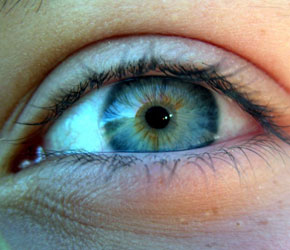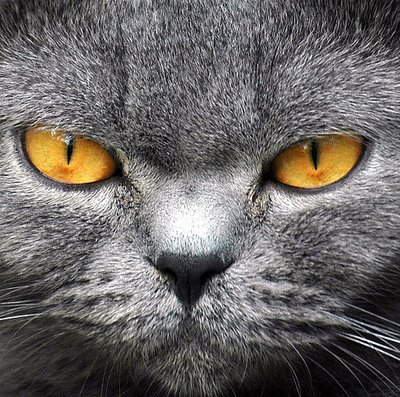Can our fellow creatures see colors the way we can? I have pondered that question awhile. The following article and pictures supply the information thoroughly.
By Dr Ivan R. Schwab
Dogs see colors, but their span of color vision closely resembles the array of colors seen by “color blind” males.

About 8%, or 1 out of 12 males (humans) and about 1 out of 200 females are “color blind.” We use that term to describe individuals who are color deficient, but they are not truly color blind. The eye has cells that perceive color and these are called cone photoreceptors or “cones.” We use another set of photoreceptors called “rods” for the black and white vision of dim light or nighttime. Our cones contain three visual pigments each of which responds to a different spectrum of wavelengths of light. It is these three visual pigments that combine their signals to permit us to have color vision by blending the signals, depending on the wavelengths received. Although it is an over-simplification, and misleading to some extent, we can describe our visual pigments as blue, green, and red. The brain receives the input from these three channels and then interprets the color we see. At least two different color channels are needed for color vision because the brain needs to “compare” these two different channels to determine color.

Color blindness in humans is caused by the genetic deficiency or loss of either the green or the red photopigment hence that input into the brain. So, the brain learns to see only those colors that can be interpreted or constructed by combining the input from the other two remaining visual pigments. The result is a less robust spectrum of colors, but colors are still seen. True color blindness in humans does exist when two of the three visual pigments are genetically unavailable, but it is exceedingly rare. If only one visual pigment channel is coming to the brain, say the blue cone input, it isn’t seen as blue but rather as on or off—hence that is “real” color blindness and would be a black and white world.
So, almost all color blindness in humans is not true color blindness but would be better described as color deficiency.
Now, let’s go back to your dog. Normal dogs have two different visual pigments in their cones, and much like humans afflicted with so-called “color blindness.” But they would see color. The color input would be weaker to some extent because dogs have fewer cones than we do because they are evolutionarily closer to their nocturnal ancestors. Cones are needed less, if at all, at night.
So, what about the other pets in the household? Your cat will have a similar color distribution as your dog although there are some subtle differences.
Birds, on the other hand, possess rich color vision, in many cases better than our own. Most birds have four cone visual pigments, although this varies. In general, birds have an additional ultraviolet pigment in their cones and many more cones than we have. Furthermore the visual pigments that would be similar to ours span different wavelengths. Their visual experience is richer than our own in ways impossible to describe or understand. Not only do they see more colors, but the interpretation of colors would be different. Think of combining different colors of paint—if you combine more colors radiating from the same object, like a flower, you will see different colors. A hummingbird, then, would see a red flower as a different color because of the ultraviolet channel input.

You may ask what good are these extra color channels in birds? Of course, it’s hard to know completely since we can’t even understand the perception of the color “ultraviolet,” but here is an example. When a mouse is being hunted by a hawk, it will often urinate out of fear and to make itself as light as possible for escape. Mouse urine radiates ultraviolet and that actually helps the hawk follow the mouse trail. Fresher urine radiates more ultraviolet light. The ultraviolet arrow will point to lunch for the hawk.

For those of you who have aquaria, the story gets even more interesting. There are at least 28,000 species of fish on earth, not to mention the staggering number of invertebrates. Although no one will have that large of an aquarium, commercially available animals for aquaria are quite numerous and it is harder to generalize about them. Many fish have four visual pigments or channels and, like birds, even the three that would resemble our own, span different wavelengths and provide more robust color vision. That is a very different story.
Hence, the answer to the question of “Does my dog see in color?” is “yes” although not as well as you probably do.
The next question you might ask is “Does my octopus sees in color since it can change into so many different colors?” Surprisingly, the answer is no, because octopuses have but one visual pigment. But that is a story for another day.
Dr. Ivan R. Schwab, a professor at the University of California, Davis, is the author of Evolution’s Witness: How Eyes Evolved. He also has a blog which you can find here.


















